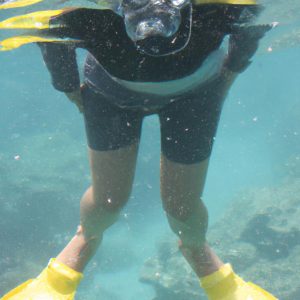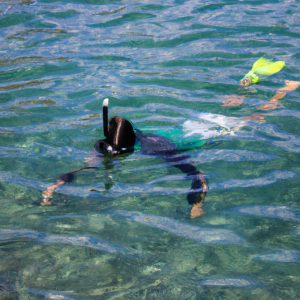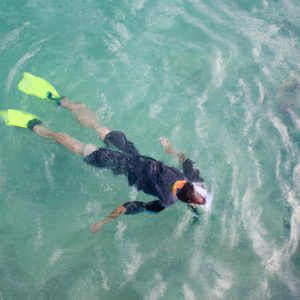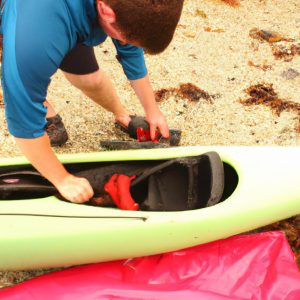Coral Reefs: A Guide for Snorkeling Enthusiasts in Water Sports

Coral reefs, the vibrant and diverse ecosystems found in shallow tropical waters, are a playground for snorkeling enthusiasts and water sports lovers. These underwater marvels teem with an array of marine life, dazzling colors, and intricate formations that captivate the imagination of those who explore them. One can only imagine the thrill of gliding through crystal clear waters, surrounded by schools of colorful fish and swaying coral branches. However, to fully appreciate these delicate ecosystems while minimizing our impact on them, it is essential for snorkelers to have a comprehensive understanding of coral reef biology, conservation efforts, and responsible snorkeling practices.
In recent years, there has been growing concern about the health and future survival of coral reefs due to rising ocean temperatures, pollution, and human activities such as overfishing or careless anchoring. For instance, let us consider a hypothetical case study where a popular tourist destination experienced significant damage to its coral reefs after an influx of unregulated tourism led to excessive foot traffic and irresponsible behavior from visitors. The decline in reef health not only impacted the local ecosystem but also had severe economic consequences for the region’s tourism industry. This example highlights the urgent need for education and awareness among snorkelers so that they can contribute positively towards preserving these precious ecosystems.
To address this issue, snorkelers can take several steps to ensure they are responsible and environmentally conscious while enjoying coral reefs. Firstly, it is crucial to educate oneself about the biology of coral reefs and their conservation needs. Understanding the delicate balance of these ecosystems, including the symbiotic relationship between corals and other marine organisms, will foster a deeper appreciation for their fragility.
Snorkelers should also be aware of the potential threats they may pose to coral reefs. One way to minimize impact is by practicing proper buoyancy control and avoiding touching or standing on the reef. Even small touches can harm the fragile coral polyps and disrupt their growth. It is advisable to stay at a safe distance from corals and respect their space.
Furthermore, using reef-safe sunscreen is essential as certain chemicals commonly found in sunscreens can be harmful to corals. Look for products that are labeled “reef-friendly” or use alternative methods of sun protection such as rash guards or UV-protective clothing.
Responsible snorkeling practices also include not feeding or touching marine life and refraining from collecting souvenirs such as shells or pieces of coral. These actions can disturb natural behaviors and disrupt the delicate ecological balance within coral reef ecosystems.
Lastly, supporting local conservation organizations and initiatives dedicated to preserving coral reefs is another effective way to contribute positively. By volunteering, donating, or participating in educational programs, snorkelers can actively engage in efforts that aim to protect these valuable ecosystems.
In conclusion, with proper knowledge and responsible behavior, snorkelers can play a significant role in preserving coral reefs for future generations. By understanding the importance of conservation efforts and implementing responsible snorkeling practices, we can help ensure that these vibrant underwater wonders continue to thrive for years to come.
Understanding Coral Reefs
Imagine floating above a vibrant underwater world, surrounded by an array of colorful fish and mesmerizing coral formations. This is the allure of snorkeling in coral reefs – an experience that brings us closer to the wonders of marine life. In order to fully appreciate these delicate ecosystems, it is essential to understand their composition, significance, threats they face, and ways we can contribute to their conservation.
Coral reefs are diverse underwater structures formed from the accumulation of calcium carbonate secreted by corals. They support one-quarter of all marine species on Earth, making them highly productive and biodiverse habitats. These intricate systems thrive in warm, clear waters with optimal sunlight penetration. For instance, Australia’s Great Barrier Reef spans over 2,300 kilometers and shelters more than 1,500 species of fish along with countless other organisms.
However, despite their beauty and ecological importance, coral reefs worldwide are facing numerous challenges. Climate change-induced rising sea temperatures pose a significant threat as increased oceanic heat leads to coral bleaching—a phenomenon where corals expel their symbiotic algae due to stress. Pollution from coastal development activities further degrades water quality around reefs. Overfishing disrupts the balance between predator and prey species within reef ecosystems.
To evoke an emotional response towards protecting coral reefs:
- Increased awareness: Understanding the fragility of coral reefs emphasizes our responsibility in preserving these invaluable ecosystems.
- Astonishment at biodiversity: The stunning variety of flora and fauna found within coral reefs showcases nature’s remarkable ability to create complex habitats.
- Sense of urgency: Recognizing the imminent danger posed by climate change urges us to take immediate action for conserving these vulnerable environments.
- Hope for preservation: Realizing that collective efforts can make a difference instills optimism in safeguarding these natural treasures for future generations.
Table showcasing examples of endangered coral species:
| Species Name | Threat Level | Habitat Range |
|---|---|---|
| Acropora palmata | Critically Endangered | Caribbean Sea |
| Porites compressa | Vulnerable | Indian and Pacific Oceans |
| Pocillopora damicornis | Near Threatened | Red Sea, Indo-Pacific |
| Echinopora lamellosa | Endangered | Southeast Asia |
Understanding the intricate nature of coral reefs is crucial for their conservation. By recognizing their composition, significance, and the threats they face, we can take proactive steps to protect these fragile ecosystems.
Transitioning into the subsequent section about “Choosing the Right Snorkeling Gear,” it is important to equip ourselves with suitable gear that ensures a safe and enjoyable snorkeling experience amidst coral reef environments.
Choosing the Right Snorkeling Gear
Imagine yourself snorkeling in the warm, turquoise waters of a tropical paradise. As you swim among the vibrant coral reefs, you are surrounded by an array of colorful fish and fascinating marine life. This is just one example of the awe-inspiring experiences that await snorkeling enthusiasts in water sports. In order to fully appreciate and protect these delicate ecosystems, it is essential to have a solid understanding of coral reefs.
Firstly, let us explore the incredible biodiversity found within coral reefs. These underwater wonderlands are home to countless species, from tiny plankton to majestic sea turtles. They provide shelter and nourishment for an astonishing variety of marine organisms, making them some of the most productive ecosystems on Earth. It’s truly remarkable how such small creatures can create such vast and intricate habitats.
Secondly, it is important to recognize the fragility of coral reefs. Despite their beauty and resilience, they face numerous threats due to human activities. Pollution, overfishing, climate change, and physical damage from tourism all contribute to the degradation of these precious ecosystems. Without proper conservation efforts, we risk losing not only the stunning sights but also the vital ecological services provided by coral reefs.
To better understand why we must take action to preserve coral reefs, consider the following emotional response-inducing bullet points:
- The mesmerizing colors and patterns exhibited by corals create a visually stunning experience.
- Snorkeling alongside gentle giants like manta rays or whale sharks can invoke feelings of awe and wonder.
- Witnessing baby sea turtles hatchling on a pristine beach instills hope for future generations.
- Knowing that your actions as a responsible snorkeler can directly impact the health and preservation of these fragile ecosystems brings about a sense of responsibility.
Additionally, here is a three-column table highlighting both positive aspects and potential dangers associated with coral reef snorkeling:
| Positive Aspects | Dangers |
|---|---|
| Rich biodiversity | Physical damage |
| Awe-inspiring beauty | Overfishing |
| Educational opportunities | Climate change effects |
In conclusion, understanding the importance of coral reefs is crucial for snorkeling enthusiasts in water sports. By recognizing their incredible biodiversity and vulnerability to human activities, we can develop a deeper appreciation for these underwater ecosystems. It is our responsibility as snorkelers to do our part in protecting and preserving coral reefs for future generations.
Transitioning into the subsequent section on “Safety Tips for Snorkeling in Coral Reefs,” it is essential to be well-prepared before embarking on any underwater adventure. Let us now explore some guidelines that will ensure an enjoyable and safe experience while exploring these captivating environments.
Safety Tips for Snorkeling in Coral Reefs
Imagine this scenario: you’ve arrived at a breathtaking coral reef, ready to embark on an unforgettable snorkeling adventure. As you gear up and prepare to dive into the crystal-clear waters, it’s crucial to prioritize safety. By following these essential tips, you can ensure a safe and enjoyable experience while exploring the wonders of coral reefs.
-
Be Mindful of Your Surroundings:
Before entering the water, take some time to observe your surroundings. Look for any potential hazards such as strong currents or sharp coral formations that may pose risks during your snorkeling expedition. Identifying these dangers early on ensures that you can navigate through the reef responsibly. -
Protect Yourself from Sunburn:
Spending extended periods in tropical waters exposes your skin to intense sunlight. To safeguard against sunburn, apply waterproof sunscreen with a high SPF before heading out. Additionally, consider wearing protective clothing like long-sleeved rash guards and wide-brimmed hats to shield yourself from harmful UV rays. -
Practice Responsible Snorkeling Techniques:
Respecting marine life is paramount when exploring coral reefs. Ensure not to touch or disturb any creatures or corals you encounter along the way; remember, they are delicate ecosystems that require our protection and preservation. Maintain a comfortable distance to avoid accidental damage while still experiencing their awe-inspiring beauty. -
Dispose of Waste Properly:
As responsible snorkelers, we must keep our oceans clean by minimizing pollution caused by human activities. Carry a reusable bag with you to collect any trash floating nearby or litter left behind by others (if safe to do so). Remember, even small actions collectively make a significant impact in preserving these fragile environments for future generations.
Here are four ways we can contribute positively towards protecting coral reefs:
- Participate in local beach clean-up initiatives.
- Support organizations working toward marine conservation efforts.
- Educate ourselves about sustainable fishing practices and promote their adoption.
- Advocate for the reduction of single-use plastics in our daily lives.
| Ways to Protect Coral Reefs | Importance | Impact |
|---|---|---|
| Participate in beach clean-ups | Reduces pollution | Preserves ecosystem |
| Support marine conservation orgs. | Funds research & education | Promotes preservation |
| Practice sustainable fishing | Maintains healthy fish populations | Ensures balance |
| Reduce single-use plastic usage | Minimizes waste | Prevents pollution |
By adhering to these guidelines, we can help preserve coral reefs’ delicate ecosystems while enjoying an enriching snorkeling experience. In the subsequent section, we will delve into identifying common species found within these vibrant underwater habitats, further enhancing your appreciation for their remarkable biodiversity.
Identifying Common Coral Reef Species
Imagine snorkeling in crystal-clear waters, surrounded by a vibrant underwater world. As you glide through the ocean, you spot a majestic sea turtle gracefully swimming among colorful coral reefs. This encounter highlights just one aspect of the incredible biodiversity found within these marine ecosystems.
Coral reefs are home to countless species that contribute to their intricate web of life. Let’s delve deeper into this captivating realm and discover some common inhabitants you may encounter during your snorkeling adventures:
- Clownfish (Amphiprioninae): These small, brightly colored fish with distinctive stripes can often be seen darting in and out of anemones.
- Parrotfish (Scaridae family): Known for their vibrant colors and beak-like mouths, parrotfish play a crucial role in maintaining healthy reef systems by grazing on algae-covered surfaces.
- Moray eels (Muraenidae family): With elongated bodies and sharp teeth, moray eels hide within crevices during the day but emerge at night to hunt for prey.
- Sea stars (Asteroidea class): These fascinating creatures exhibit remarkable diversity in shape, color, and size. From cushion stars to brittle stars, they add splashes of beauty wherever they dwell.
As you explore these extraordinary habitats, it is essential to respect and protect them. Here are some guidelines to ensure minimal impact on coral reefs:
| Minimizing Impact on Coral Reefs | Why It Matters |
|---|---|
| Wear reef-safe sunscreen | Traditional sunscreens containing oxybenzone and octinoxate harm coral larvae and disrupt their growth |
| Avoid touching or stepping on corals | Physical contact can cause damage or even mortality to fragile coral structures |
| Refrain from feeding marine life | Feeding alters natural behaviors and can lead to imbalances within the ecosystem |
| Practice responsible anchoring | Properly moor your boat to prevent anchor damage to delicate coral formations |
By adhering to these principles, you can preserve the exceptional beauty and biodiversity of coral reefs for future generations. Next, we will explore techniques for minimizing our impact on these fragile ecosystems as we continue our snorkeling journey.
[Transition Sentence] Now let’s discuss some effective strategies for reducing our footprint while enjoying the wonders of coral reefs in “Minimizing Impact on Coral Reefs” section.
Minimizing Impact on Coral Reefs
Imagine you are snorkeling in the crystal-clear waters of a vibrant coral reef. As you glide through the colorful underwater world, observing an array of fascinating marine life, it is crucial to be mindful of your actions and minimize any potential harm to this delicate ecosystem. By adopting responsible practices, we can ensure the preservation of these magnificent coral reefs for future generations.
To effectively protect coral reefs while engaging in water sports activities like snorkeling, consider implementing the following measures:
-
Practice Proper Buoyancy Control:
- Mastering buoyancy control allows you to navigate without damaging fragile corals.
- Avoid touching or standing on corals as they are living organisms that require protection from excessive human contact.
-
Use Environmentally-Friendly Sunscreens:
- Many conventional sunscreens contain chemicals harmful to coral reefs.
- Opt for mineral-based sunscreens labeled “reef-safe” to safeguard both your skin and the marine environment.
-
Dispose of Waste Responsibly:
- Refrain from discarding any trash or litter into the ocean while snorkeling.
- Take all rubbish back with you and dispose of it properly on land to prevent pollution and contamination.
-
Educate Yourself and Others:
- Stay informed about local guidelines and regulations regarding snorkeling near coral reefs.
- Share your knowledge with fellow enthusiasts, encouraging them to adopt sustainable practices too.
Adhering to these principles will foster a more conscious approach towards protecting our precious coral reef ecosystems. Let us remember that every action counts when it comes to preserving these natural wonders for years to come.
Transitioning into the subsequent section about “Exploring Coral Reefs: Best Locations,” let’s now delve into discovering some remarkable destinations where you can witness the awe-inspiring beauty of coral reefs up close.
Exploring Coral Reefs: Best Locations
As snorkeling enthusiasts, it is essential to recognize the importance of minimizing our impact on coral reefs. These delicate ecosystems are highly susceptible to human interference and can be easily damaged if not approached with care. To ensure the preservation of these natural wonders for future generations, we must adopt responsible practices while exploring coral reefs.
One example that highlights the significance of minimizing impact on coral reefs involves a popular tourist destination in Southeast Asia. Over time, due to increased tourism and inadequate regulations, this once-thriving coral reef has suffered extensive damage from careless snorkelers who unknowingly stepped on or touched the corals. This case study serves as a stark reminder of how our actions can have severe consequences for fragile marine environments.
To help you become more mindful when venturing into these underwater realms, here are some guidelines to follow:
- Do not stand or touch the corals: Corals are living organisms that take years to grow and develop. When standing or touching them, we risk damaging their delicate structures.
- Avoid using sunscreen containing harmful chemicals: Certain ingredients found in common sunscreens can bleach or harm corals. Opt for reef-safe alternatives instead.
- Dispose of waste properly: Ensure any trash or debris is discarded responsibly, preferably back on land in designated bins.
- Respect wildlife: Maintain a safe distance from marine animals and refrain from feeding them as it disrupts their natural behaviors and diet.
Moreover, understanding the potential impacts caused by various activities can further guide us in protecting these ecosystems. The table below provides an overview of some common activities along with their potential effects on coral reefs:
| Activity | Potential Effects |
|---|---|
| Anchoring boats | Physical damage |
| Overfishing | Imbalance in ecological systems |
| Pollutant runoff | Water pollution |
| Dynamite fishing | Destruction of habitats |
By adhering to these guidelines and understanding the potential implications of our actions, we can contribute towards the preservation of coral reefs. Let us strive to be responsible stewards of these invaluable ecosystems, ensuring their beauty endures for generations to come.
Note: The information provided in this section is intended as a general guide. It is crucial to always consult local guidelines and regulations specific to your snorkeling location before engaging in any activities.







